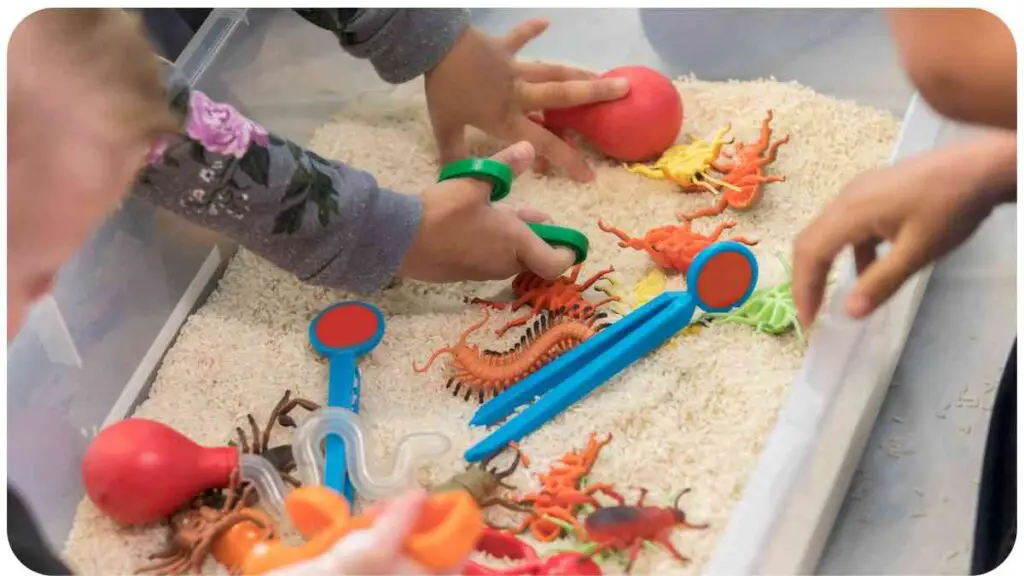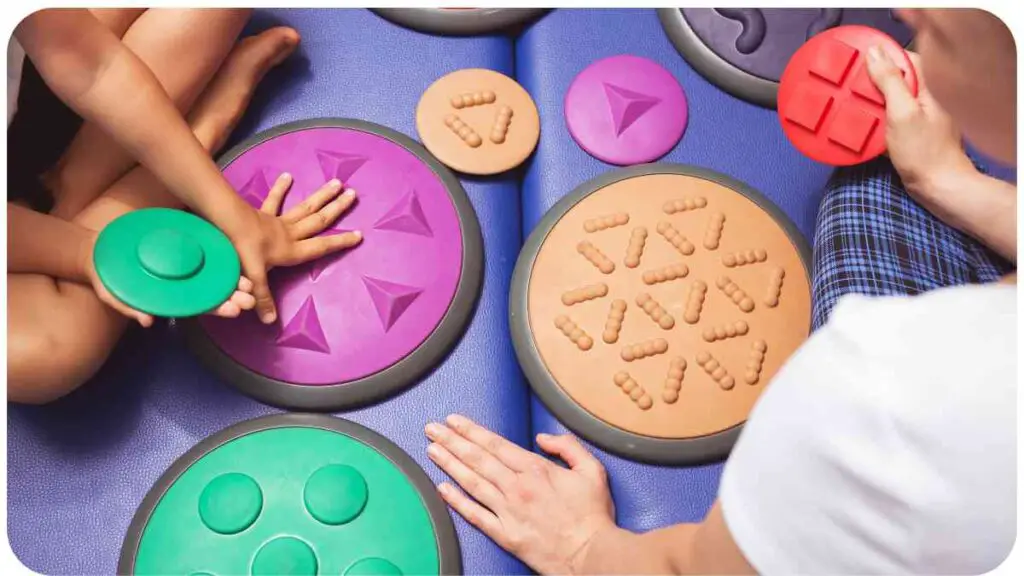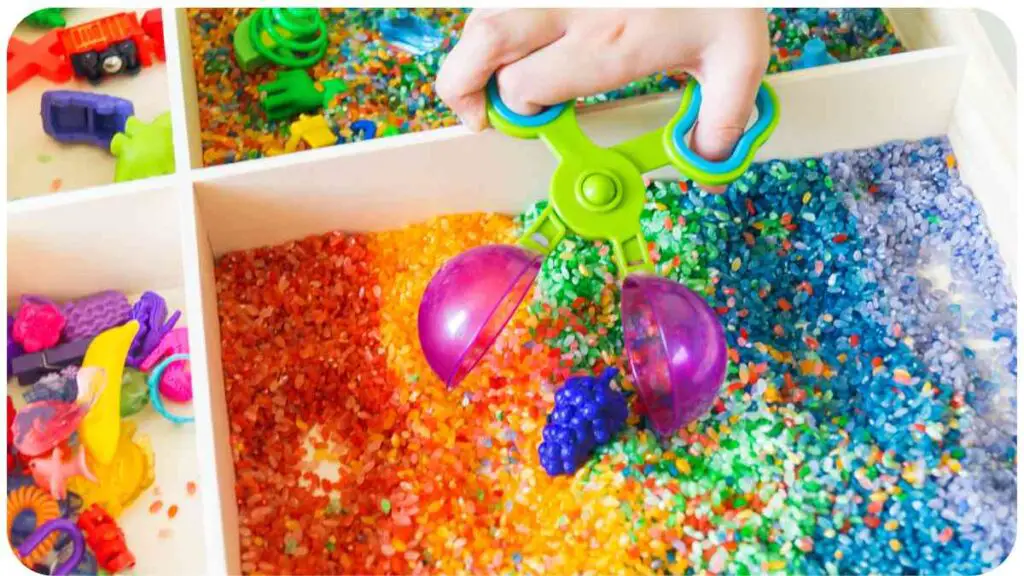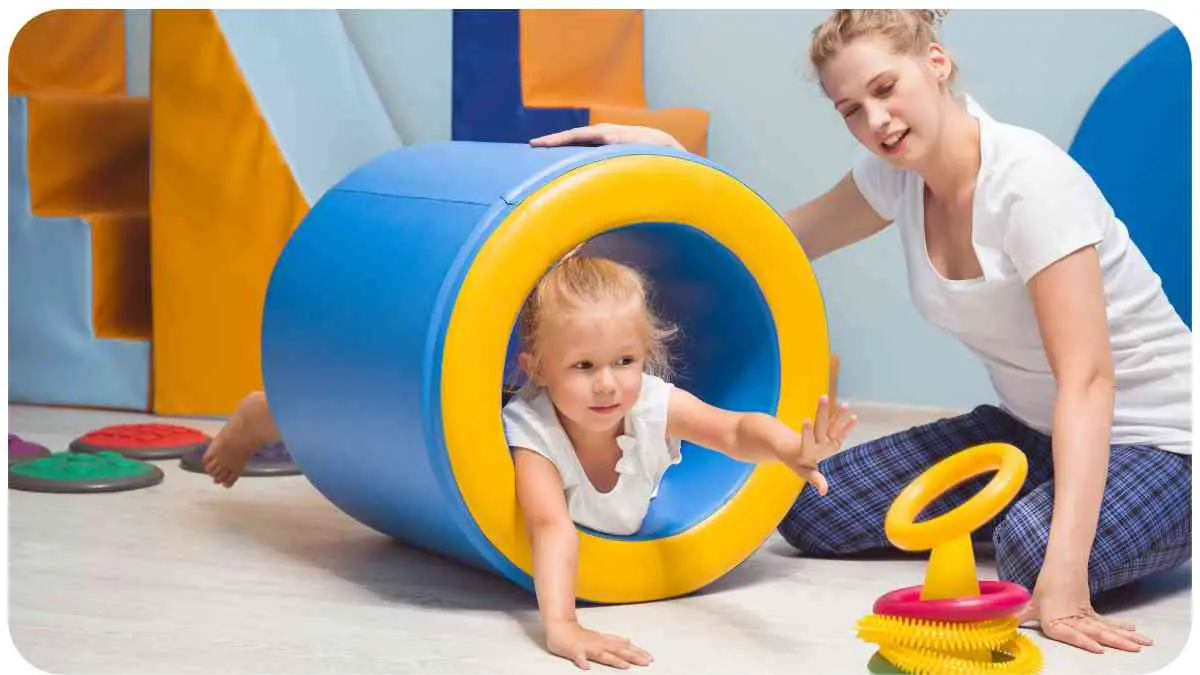Are you a parent or caregiver who has been contemplating setting up a sensory bin for your child but feeling overwhelmed by the process? Don’t worry, you’re not alone. Many individuals find themselves in this situation, unsure where to start or how to organize sensory play effectively.
In this article, we will guide you through the process of creating a well-structured and organized sensory bin that will engage and benefit your child. We’ll share insights, tips, and personal anecdotes to ensure a successful sensory play experience.
| Takeaways |
| Organizing sensory bin materials is crucial for creating a seamless play experience. |
| Utilize practical tips and strategies to keep sensory bin materials organized and easily accessible. |
| Sensory play with a well-organized bin promotes cognitive development, fine motor skills, and language development. |
| Choose a theme for your sensory bin to enhance engagement and provide a cohesive play experience. |
| Ensure the safety of your child during sensory play by selecting age-appropriate materials and maintaining supervision. |
| Sensory play can be beneficial for children with sensory processing difficulties, promoting self-regulation and sensory integration skills. |
2. Understanding Sensory Bins
Sensory bins are containers filled with various materials, such as water, sand, rice, beans, or other tactile substances, that provide a sensory-rich play experience for children. These bins offer opportunities for exploration, imagination, and learning through touch, sight, sound, and smell. Children can engage their senses while developing fine motor skills, language, and problem-solving abilities.

3. Why Organizing a Sensory Bin is Important
A well-organized sensory bin offers several benefits for both children and adults involved in the play experience. It enhances the effectiveness of sensory play sessions, ensures a safe environment, allows for easy access to materials, promotes creativity, maintains engagement, and enables the incorporation of educational elements. Organizing a sensory bin helps to optimize the overall play experience and maximize the developmental benefits for children.
“To understand the potential benefits of choosing either sensory sand or kinetic sand, it’s crucial to appreciate how sensory play can affect a child’s learning and development. This detailed article on how sensory play enhances learning and development for toddlers can give you an in-depth perspective.”
4. Key Elements of a Well-Organized Sensory Bin
To achieve an organized sensory bin, several elements should be considered. These include appropriate tools and materials, theme selection, storage solutions, safety measures, activity variations, and the incorporation of learning opportunities. By focusing on these aspects, you can create a structured and engaging sensory play space for your child that promotes both fun and development.
5. Tips for Creating a Structured Sensory Bin

Before diving into the specifics of organizing a sensory bin, it’s essential to gather the necessary tools and materials. Table 1 provides a list of recommended items that can be used while setting up a sensory bin. Having these supplies on hand will make the process smoother and more enjoyable.
“When evaluating sensory sand and kinetic sand, it is beneficial to have background knowledge about sensory toys in general. For those new to this, the article on the importance of sensory toys for toddlers: a beginner’s guide provides a great starting point.”
Table 1: Recommended Tools and Materials for Sensory Bins
| Tools and Materials | Description |
| Plastic tub or tray | Provides a contained space for sensory play |
| Scoops, spoons, or tongs | Allows for exploration and manipulation of materials |
| Containers and bowls | Facilitates sorting and pouring activities |
| Funnel or sieve | Enables sifting and controlling the flow of materials |
| Brushes or paintbrushes | Enables sensory exploration with textures and patterns |
| Small figurines or toys | Provides additional elements for imaginative play |
| Sensory-textured items | Incorporates a variety of textures, such as fabrics, feathers, or sponges |
| Items with varied scents | Adds olfactory stimulation to the sensory experience |
| Sound-producing objects | Enhances auditory exploration and sensory awareness |
| Items for color exploration | Includes different colored objects, dyes, or food coloring |
Once you have assembled the necessary tools, consider the theme of your sensory bin. Choosing a theme adds structure and coherence to the play experience. Table 2 provides examples of thematic sensory bins along with their corresponding contents to spark your creativity.
Table 2: Examples of Sensory Bin Themes and Contents
| Theme | Contents |
| Ocean | Blue-tinted water, shells, sea animal figurines, coral figurines |
| Construction site | Rice, small diggers and construction vehicles, rocks, hard hats |
| Farm | Wheat bran, toy animals, small fences, farm vehicles |
| Garden | Soil, toy plants, watering can, plastic bugs |
| Outer space | Black beans, toy rockets and spaceships, glow-in-the-dark stars |
6. Organizing the Sensory Bin Contents

Now that you have chosen a theme for your sensory bin, it’s time to organize its contents. The organization will ensure that the materials are easily accessible for play and that your child can fully engage with them. Consider the following tips while arranging your sensory bin:
- Layering: Start by adding a base material to the bin, such as sand, rice, or water beads, depending on your chosen theme. This base material serves as the foundation for the sensory play experience.
- Filling: Gradually add other tactile elements like fabrics, feathers, sponges, or textured objects according to your theme. Place them in separate sections of the bin or in different containers for easy identification and exploration.
- Sorting and Pouring: Include containers, bowls, and small buckets in your sensory bin. This allows your child to engage in sorting and pouring activities, promoting cognitive development and hand-eye coordination.
- Tools and Manipulation: Provide tools like scoops, spoons, tongs, brushes, or paintbrushes to encourage manipulation of the materials. These tools facilitate fine motor skills development and sensory exploration.
- Sensory Variations: Incorporate items with varied scents, sound-producing objects, and objects focusing on color exploration. These elements enhance sensory stimulation and broaden your child’s sensory awareness.
Remember, the organization of your sensory bin should be visually appealing and invite exploration. Consider the placement of different items, keeping in mind the ease of access and the sensory experiences you want to promote.
“One may wonder what science has to say about the comparison between sensory and kinetic sand. To delve deeper into the scientific underpinnings of sensory play, consider reading Understanding the Science Behind Sensory Play.”
7. Storage and Maintenance Tips
Proper storage of your sensory bin materials is crucial to ensure their longevity and easy retrieval for future play sessions. Here are some useful storage and maintenance tips:
- Reusable Containers: Use plastic bins or trays to store your sensory bin materials. These containers keep the items organized, prevent spills, and protect them from dust and pests.
- Labeling: Create labels for each container to easily identify the contents of the sensory bin. This saves time when setting up future sensory play sessions and encourages independence for your child to retrieve and return materials.
- Rotation System: To keep the sensory play experience fresh and engaging, consider rotating the contents of your bins periodically. This allows your child to explore different tactile sensations and themes over time.
- Maintenance: Regularly check and replace any damaged materials or items that may pose a safety risk. Remove any debris or contaminants from the sensory bin to ensure a clean and safe play environment.
By implementing these storage and maintenance practices, you can ensure that your sensory bin is always ready for engaging play while ensuring the longevity of the materials.
Next, let’s explore some common challenges that may arise during sensory play and how to address them effectively.
8. Trouble-Shooting Common Challenges
Even with careful planning and organization, sensory play can sometimes present challenges. Don’t worry, as many parents and caregivers face these hurdles. Here are some common challenges you may encounter and strategies to overcome them:
- Messy Play: Mess is often a concern for caregivers. To minimize mess, consider using a large tray or a plastic tablecloth underneath the sensory bin. This makes cleanup easier while still allowing your child to explore and engage with the materials freely.
- Sensory Overload: Some children may become overwhelmed with certain textures, scents, or sounds. If you notice signs of sensory overload, provide your child with alternatives or options. Encourage them to explore at their own pace and introduce new sensory elements gradually.
- Lack of Interest: If your child shows disinterest in the sensory bin, consider incorporating their current interests or favorite toys into the play experience. Adding elements that align with their preferences can reignite their engagement and curiosity.
- Safety Concerns: Always prioritize safety during sensory play. Ensure small objects are not accessible to younger children to avoid choking hazards. Supervise your child during play and be mindful of any potential allergies or sensitivities they may have.
By proactively addressing these challenges, you can foster an enjoyable and rewarding sensory play experience for your child.
“If you find the comparison between sensory sand and kinetic sand intriguing, you might also be interested in exploring other sensory play materials. The article discussing the pros and cons of water beads in sensory play offers additional valuable insights.”
9. Engaging Activities and Variations
To keep your child engaged and excited about sensory play, it’s important to introduce new activities and variations to the sensory bin experience. Here are some ideas to enhance the fun and learning:
- Sensory Scavenger Hunt: Hide small objects or figurines in the sensory bin and encourage your child to find and identify them. This activity promotes sensory exploration, observation skills, and object recognition.
- Sensory Bin Storytelling: Create a story or narrative around the theme of your sensory bin. Use the materials in the bin to act out the story, allowing your child to engage in imaginative play while fostering language development and storytelling skills.
- Sensory I-Spy: Add various objects, colors, or textures to the sensory bin and play an I-Spy game with your child. Take turns describing an object or texture they need to find, fostering visual discrimination skills and vocabulary development.
- Temperature Exploration: Introduce elements of different temperatures to your sensory bin. For example, you can have warm water, ice cubes, or frozen objects. This adds a new sensory dimension and enhances the tactile experience for your child.
- Mess-Free Sensory Bags: Seal some of the sensory materials, such as colored rice or textured fabric, in resealable plastic bags. This allows for mess-free sensory exploration, especially for younger children or those who prefer a cleaner play experience.
Table 3: Activity Ideas for Sensory Bins
| Activity | Description |
| Sensory Scavenger Hunt | Hide objects in the sensory bin for your child to find and identify. |
| Sensory Bin Storytelling | Create narratives and act them out using the materials in the sensory bin. |
| Sensory I-Spy | Play a game of I-Spy, describing objects or textures your child needs to find. |
| Temperature Exploration | Add elements of different temperatures, such as warm water or frozen objects. |
| Mess-Free Sensory Bags | Seal sensory materials in resealable plastic bags for cleaner sensory exploration. |
By incorporating these activity ideas into your sensory play sessions, you can create a dynamic and diverse experience that keeps your child engaged and eager to explore.
“The choice between sensory sand and kinetic sand is part of a broader discussion about the role of sensory toys in child development. For a holistic view, you might want to check out the article on understanding the importance of sensory toys for child development.”
10. Incorporating Learning and Development
Sensory play not only offers entertainment but also serves as a valuable opportunity for learning and development. Here are some ways to incorporate educational elements into your sensory bin:
- Counting and Sorting: Use small objects or materials in the sensory bin for counting and sorting activities. Encourage your child to group items by color, shape, or size, fostering early math skills and cognitive development.
- Alphabet Sensory Bins: Incorporate letters of the alphabet into your sensory bin. Your child can dig through the materials to find specific letters, helping them recognize and learn letter sounds and formations.
- Sensory Science Experiments: Introduce science concepts into sensory play by incorporating simple experiments. For example, let your child explore how different materials float or sink in water or create fizzing reactions with baking soda and vinegar.
- Sensory Writing Tray: Use a shallow tray filled with sand, salt, or flour as a sensory writing tray. Your child can practice forming letters, numbers, or shapes, developing pre-writing skills and hand-eye coordination.
By incorporating learning opportunities into sensory play, you can nurture your child’s cognitive abilities, language development, and fine motor skills in an engaging and fun-filled way.
Now, let’s address parental concerns surrounding sensory play and highlight its numerous benefits.
11. Ensuring Safety in Sensory Play
Parents and caregivers may have concerns about safety when it comes to sensory play. Here are some measures to ensure a safe and enjoyable sensory play experience:
- Adult Supervision: Always supervise your child during sensory play, especially with younger children. This allows you to address any safety concerns that may arise and provide guidance when needed.
- Age-Appropriate Materials: Choose materials that are suitable for your child’s age and development level. Ensure that there are no small objects that pose choking hazards, and be mindful of any allergies or sensitivities your child may have.
- Non-Toxic and Child-Safe: When selecting materials for sensory bins, opt for non-toxic and child-safe options. Avoid using substances that may be harmful if ingested or materials that have sharp edges.
- Allergen Awareness: Be cautious if your child has known allergies or sensitivities. Avoid materials that may trigger an allergic reaction or make sure to take appropriate precautions, such as using gloves when handling certain substances.
- Hygiene Practices: Encourage regular handwashing before and after sensory play to maintain cleanliness and prevent the spread of germs. Also, wash sensory materials, such as fabrics or toys, regularly to ensure hygiene.
By prioritizing safety measures and making informed choices regarding materials and supervision, you can create a safe and secure environment for sensory play, allowing your child to explore and learn without worry.
12. Overcoming Parental Concerns
Parents and caregivers may have valid concerns or reservations about sensory play. Here are some common concerns and suggestions on how to address them:
- M ess and Cleanliness: Mess can be a concern, but there are ways to manage it. Place a large tray or tablecloth underneath the sensory bin to contain spills and make cleanup easier. You can also establish ground rules with your child about cleanup and use aprons or smocks to protect clothing.
- Sensory Overload: Some parents worry that sensory play might overwhelm their child. Start with materials and sensations that are familiar and gradually introduce new ones. Observe your child’s reactions and provide breaks if needed. Sensory play should be an enjoyable and positive experience.
- Allergies and Sensitivities: If your child has allergies or sensitivities, be mindful of the materials you use in the sensory bin. Avoid known allergens and test new materials in small quantities before introducing them to your child. Always consult with a healthcare professional if you have specific concerns.
- Developmental Benefits: Sensory play offers numerous developmental benefits for children, including cognitive, language, fine motor, and social skills. Understanding the wide range of benefits and the importance of sensory exploration can help alleviate concerns and highlight the value of this type of play.
- Age-Appropriate Materials: Choose materials that are suitable for your child’s age and developmental stage. Avoid small objects that may pose a choking hazard and ensure that the sensory bin materials are safe and non-toxic. Always supervise your child during sensory play to maintain their safety.
By acknowledging and addressing parental concerns, you can gain confidence in providing sensory play opportunities for your child, knowing that their well-being and developmental growth are prioritized.
13. Conclusion
Organizing a sensory bin may initially seem overwhelming, but with the right approach, it can become a valuable and enjoyable activity for your child. By focusing on organization, storage, age-appropriate materials, and engaging activities, you can create a structured and beneficial sensory play experience.
Remember to prioritize safety and address parental concerns to foster a positive and enriching environment for sensory exploration and learning. Embrace the opportunity to engage your child’s senses and watch them thrive through the wonders of sensory play.
Further Reading
Here are some additional resources for further reading on organizing sensory bin materials:
- Practical Perfection: How to Organize Sensory Bin Materials: This article provides practical tips and strategies for organizing and storing sensory bin materials to create a seamless and engaging play experience.
- Supports for Special Students: 5 Tips for Sensory Bin Organization: Explore this blog post to discover five valuable tips for organizing sensory bin materials, ensuring accessibility and promoting independence.
- Baby Chick: Sensory Bin Ideas – What They Are and How to Make Them: If you’re looking for inspiration and ideas for sensory bins, this article provides an overview of what sensory bins are and offers creative suggestions for making them.
FAQs
Here are some frequently asked questions about sensory bin organization:
What are the benefits of sensory play with a well-organized bin?
Engaging in sensory play with a well-organized bin promotes cognitive development, fine motor skills, language development, problem-solving abilities, and sensory awareness. It also enhances creativity and imagination while providing a calming and therapeutic experience.
How can I keep sensory bin materials organized and accessible?
Using reusable containers, labeling them, and employing a rotation system can help keep sensory bin materials organized and easily accessible for future play sessions. Regular maintenance and storage practices also contribute to preserving the materials and ensuring their longevity.
Should I choose a specific theme for my sensory bin?
Choosing a theme for your sensory bin can add an extra layer of excitement and engagement for your child. It helps create a cohesive play experience and allows for exploration and learning centered around a particular concept or topic.
How can I ensure the safety of my child during sensory play?
Supervision is essential during sensory play, especially for younger children. It’s crucial to select age-appropriate materials, avoid choking hazards, and consider any allergies or sensitivities your child may have. Regularly check the materials for damage and maintain a clean play environment.
Can sensory play help with sensory processing difficulties?
Yes, sensory play can be beneficial for children with sensory processing difficulties. It provides a controlled and enjoyable environment for sensory exploration, allowing them to gradually adjust and adapt to different stimuli, thus promoting self-regulation and sensory integration skills.

Meet Hellen James, the multi-talented writer and nurturing mother who takes young readers on a thrilling journey through her sensory-infused blog. Drawing inspiration from her own experiences as a parent.

